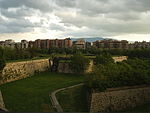Pamplona

Pamplona (Spanish: [pamˈplona]; Basque: Iruña [iɾuɲa] or Iruñea [iɾuɲe.a];), historically also known as Pampeluna in English, is the capital city of the Chartered Community of Navarre, in Spain. It is also the third-largest city in the greater Basque cultural region. Lying at near 450 m (1,480 ft) above sea level, the city (and the wider Cuenca de Pamplona) is located on the flood plain of the Arga river, a second-order tributary of the Ebro. Precipitation-wise, it is located in a transitional location between the rainy Atlantic northern façade of the Iberian Peninsula and its drier inland. Early population in the settlement traces back to the late Bronze to early Iron Age, even if the traditional inception date refers to the foundation of Pompaelo by Pompey during the Sertorian Wars circa 75 BCE. During Visigothic rule Pamplona became an episcopal see, serving as a staging ground for the Christianization of the area. It later became one of the capitals of the Kingdom of Pamplona/Navarre. The city is famous worldwide for the running of the bulls during the San Fermín festival, which is held annually from July 6 to July 14. This festival was brought to literary renown with the 1926 publication of Ernest Hemingway's novel The Sun Also Rises. It is also home to Osasuna, the only Navarrese football club to have ever played in the Spanish top division.
Excerpt from the Wikipedia article Pamplona (License: CC BY-SA 3.0, Authors, Images).Pamplona
Calle del Bosquecillo, Pamplona San Juan
Geographical coordinates (GPS) Address Nearby Places Show on map
Geographical coordinates (GPS)
| Latitude | Longitude |
|---|---|
| N 42.816666666667 ° | E -1.65 ° |
Address
Portal de San Nicolás
Calle del Bosquecillo
31071 Pamplona, San Juan
Navarre, Spain
Open on Google Maps








